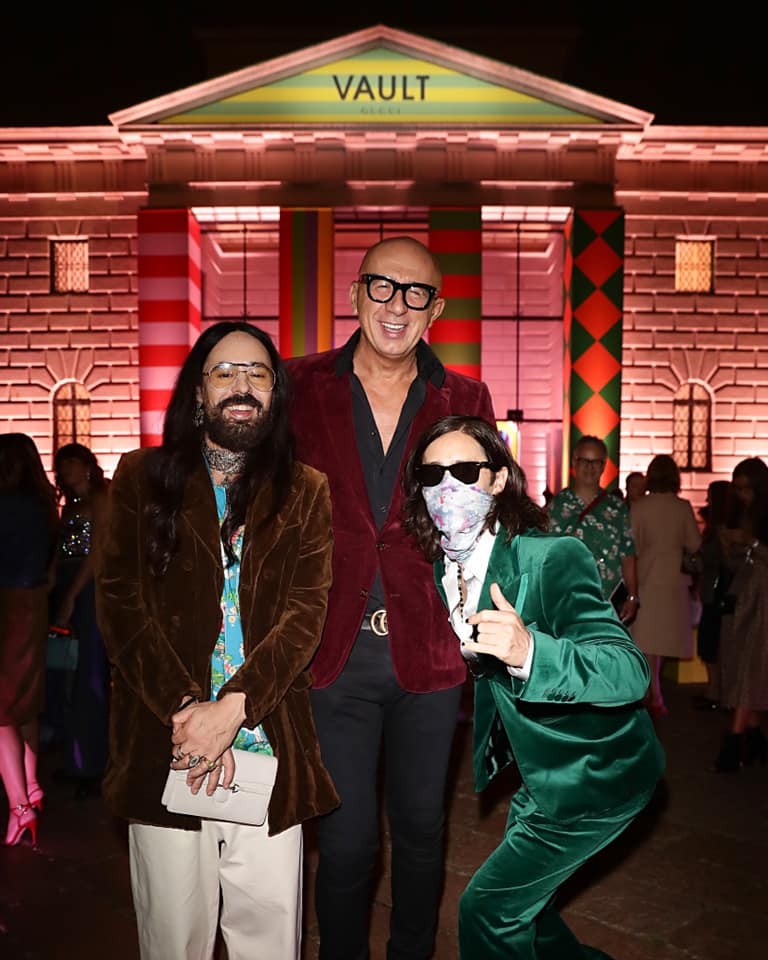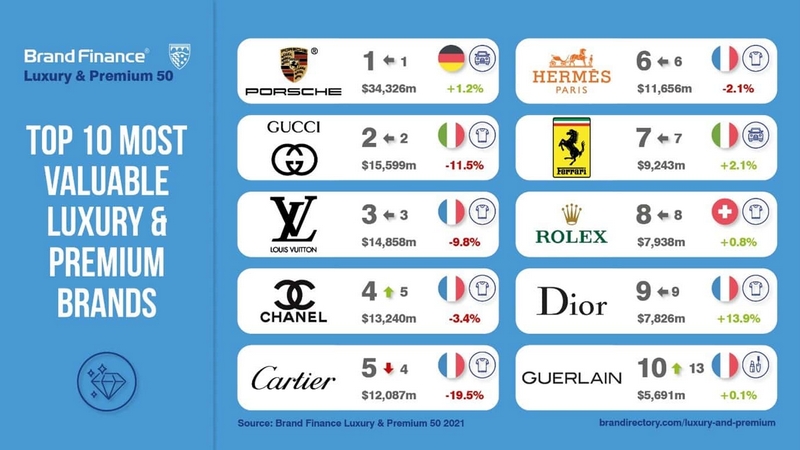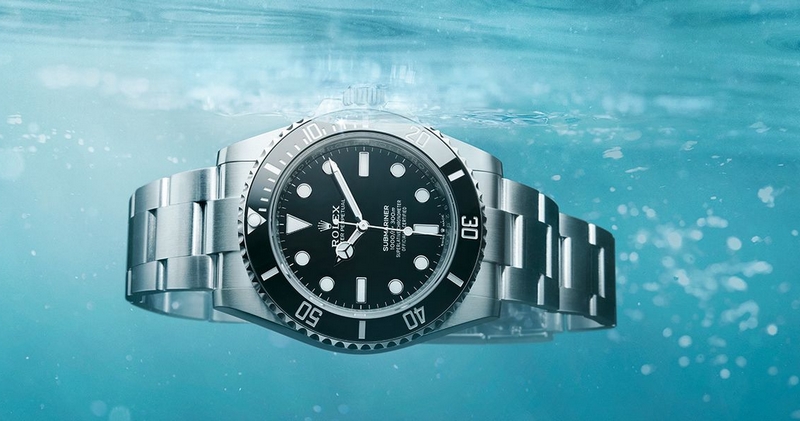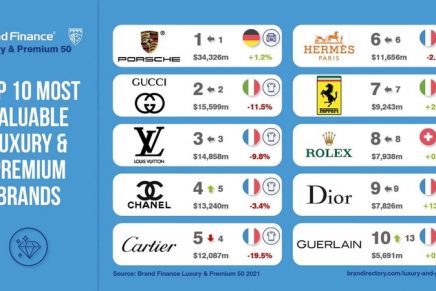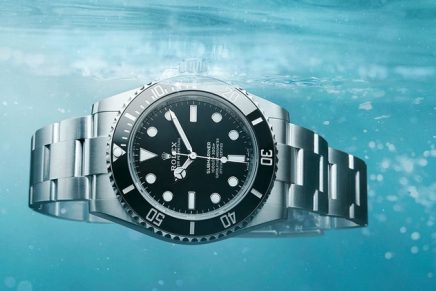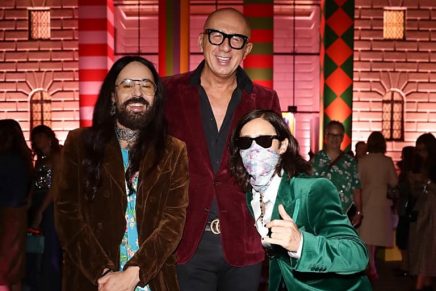Total value of world’s top 50 most valuable luxury and premium brands down 3%, from US$227.1 billion in 2020 to US$219.5 billion in 2021
Porsche retains top spot, brand value US$34.3 billion. Apparel brands dominate ranking, with 30 brands featuring and accounting for 62% of total brand value, but brand values suffer due to COVID-19.
Top 50 loses over $7 billion in brand value
The total value of the world’s top 50 most valuable luxury and premium brands, according to the Brand Finance Luxury & Premium 50 2021 report, has declined by 3% year-on-year, from US$227.1 billion in 2020 to US$219.5 billion in 2021 as the world grapples with the fallout from the COVID-19 pandemic.
“As predicted, the COVID-19 pandemic has damaged brand values across the luxury & premium sector with the total brand value of the world’s top 50 most valuable down 3% year-on-year. It is not all doom and gloom though, the pandemic can be used as a catalyst for change across the sector, through growing e-commerce channels or through brands’ responses to the increased consumer demand for social and sustainable action.” – Alex Haigh, Valuation Director, Brand Finance.
Germany’s Porsche is by far the most valuable luxury & premium brand with a brand value of US$34.3 billion, considerably ahead of second-ranked GUCCI (brand value down 12% to US$15.6 billion).
Synonymous with timeless class and luxury, Porsche is striving towards pushing the boundaries and redefining the future of the sportscar. As part of the brand’s ‘Strategy 2025’, the auto giant aims to maintain the traditional aspects that the brand is known for, as well as undertaking the shift towards sustainability through the launch of the Taycan. Porsche celebrated strong sales of the Taycan, which totalled over 20,000 units sold last year, despite a six week pause in production due to the pandemic. This impressive result means that over 10% of Porsche’s sales are now from its EV models.
Apparel brands dominate ranking but struggle amid pandemic
Apparel brands dominate the Brand Finance Luxury & Premium 50 2021 ranking, with the 30 brands that feature accounting for 62% of the total brand value. Performances across the board have been impacted by the pandemic, however, with the majority of brands recording a brand value loss this year.
Coach has recorded the biggest drop in brand value this year in the apparel subsector, falling 31% to US$4.7 billion. Coach’s sales and profits have taken a hit over the previous year. Coach’s parent company, Tapestry, has however cited that forecasts across its brands are looking more positive than anticipated thanks to triple digit e-commerce growth and a strong rebound across the Chinese market. Coach has continued to embrace its strategy of celebrity-endorsed partnerships and collections, the latest of which, saw the appointment of superstar Jennifer Lopez as the global face of the brand.
Bucking the trend is France’s Celine, which is the fastest growing luxury and premium brand this year, recording an impressive 118% brand value increase to US$1.5 billion and simultaneously jumping 13 spots to 34th. Under the helm of Hedi Slimane, Celine has successfully managed to infiltrate the burgeoning Gen Z generation across the Asian market as it rises in popularity thanks to dressing popular K-drama characters in its garments.
Hotels check into ranking for first time
For the first time the Brand Finance Luxury & Premium ranking includes two hotel brands: Shangri-La (brand value US$2.0 billion) in 29th spot and Intercontinental (brand value US$1.5 billion) in 35th. As holidays are cancelled and people are instructed to work from home, the hospitality sector has reached an almost complete standstill both from tourism, as well as corporate travel and hotel brand values have suffered as a result.
Home to five-star luxury properties with elite postcodes and addresses across the Middle East, Asia, North America, and Europe, Shangri-La is the highest ranked hotel brand in 29th position. Despite challenges, the hotel recorded an encouraging recovery across mainland China over the last year with demand being supported by an uptick in domestic leisure travel.
Ferrari speeds ahead as sector’s strongest
In addition to measuring overall brand value, Brand Finance also evaluates the relative strength of brands, based on factors such as marketing investment, customer familiarity, staff satisfaction, and corporate reputation. According to these criteria, Ferrari (up 2% to US$9.2 billion) is the world’s strongest luxury & premium brand – and the second strongest brand in the world according to the Brand Finance Global 500 2021 ranking – with a Brand Strength Index (BSI) score of 93.9 out of 100 and a corresponding elite AAA+ brand strength rating.
Ferrari reacted proactively to the pandemic, initially shutting down production and then reopening with a focus on creating a safe working environment. This both minimised disruption and reinforced the brand’s reputation as a high-quality and responsible firm. In line with this, Ferrari ranks high for reputation in our Global Brand Equity Monitor study, particularly in Western Europe (in the top 3 of all brands researched in each of France, Italy, and the UK). Ferrari remains a highly desired brand, albeit aspirational rather than accessible for many.
Alongside revenue forecasts, brand strength is a crucial driver of brand value. As Ferrari’s brand strength maintained its rating, its brand value grew, improving 2% to US$9.2 billion. For years, Ferrari has utilised merchandise to support brand awareness and diversify revenue streams and is now taking steps to preserve the exclusivity of the brand, planning to reduce current licensing agreements by 50% and eliminate 30% of product categories.
Sitting behind Ferrari as the second strongest luxury & premium brand is Rolex (up 1% to US$7.9 billion) with a Brand Strength Index (BSI) score of 89.6 out of 100 and a AAA+ brand strength rating. Rolex is renowned for its world-leading quality and exclusivity, with the brand’s new releases known for setting the standard across the watch sector. Despite the challenges of the last year, the market for luxury watches has shown remarkable resilience to the pandemic turmoil, with demand remaining stable, demonstrated by Rolex’s website traffic experiencing a surge over the previous year.

